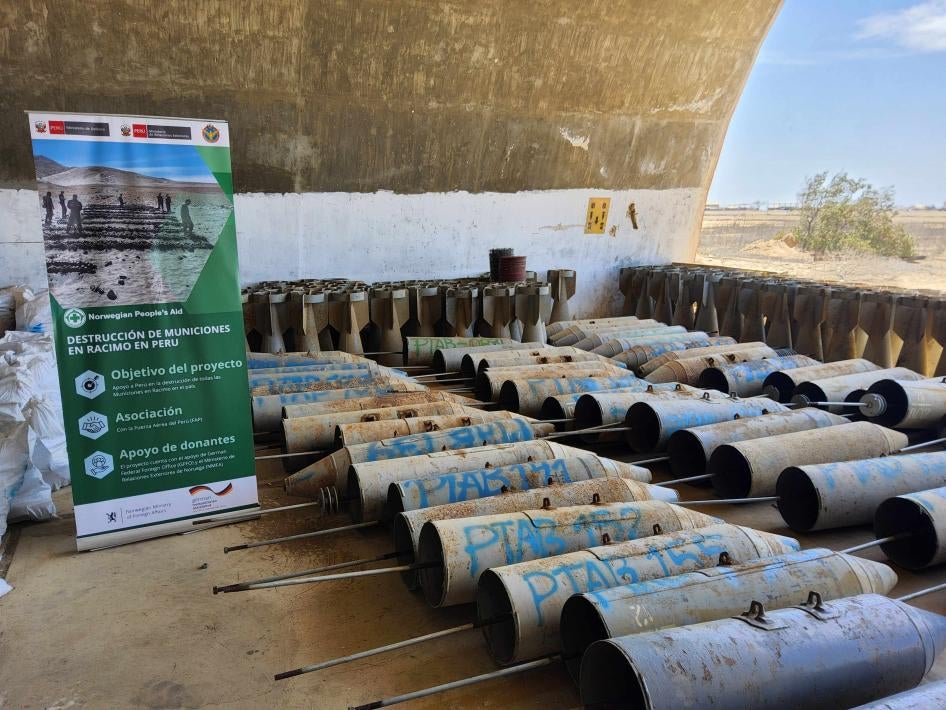(New York, December 18, 2023) – Peru’s destruction of its stocks of cluster munitions is a major milestone for the international treaty banning the weapons, Human Rights Watch said today. Peru was the last state party to complete this crucial obligation, highlighting the global rejection of cluster munitions, even as countries that have not joined the Convention on Cluster Munitions continue to use, produce, and transfer them.
“Peru’s elimination of its cluster munitions stocks is a crowning achievement in fulfilling the terms of the Convention on Cluster Munitions,” said Mary Wareham, arms advocacy director at Human Rights Watch. “Countries should apply equal vigor and determination to clearing and destroying cluster munition remnants from contaminated areas and to assisting victims of these weapons.”
The 2008 Convention on Cluster Munitions, to which 112 countries including Peru are party, comprehensively bans cluster munitions and requires the destruction of stockpiles, clearance of cluster munition remnants, and assistance to victims of the weapons.
Peru never produced or used cluster munitions, but it imported them in the past, before adopting the convention, which entered into force in Peru in 2013. It began to destroy a stockpile of 2,012 air-dropped cluster munitions and 162,417 submunitions in 2017. Peru initially committed to destroy the stocks by the convention’s deadline of March 2021, but subsequently requested and received a three-year extension.
Peru finished the destruction process on December 15, 2023, becoming the last state party to complete this obligation.
According to the Cluster Munition Monitor, which Human Rights Watch helps to produce, prior to the start of the global effort to ban cluster munitions, approximately 95 countries stockpiled millions of cluster munitions, containing more than one billion submunitions.
Article 3 of the Convention on Cluster Munitions requires each state party to declare and destroy all stockpiled cluster munitions under its jurisdiction or control as soon as possible, but no later than eight years after the treaty enters into force for that country.
In total, states parties to the convention have destroyed 1.489 million cluster munitions and 179 million submunitions, 100 percent of the cluster munition stocks declared. Of the 112 states that have ratified the Convention on Cluster Munitions, 43 states parties declared stocks of cluster munitions that they have now completely destroyed, while the rest never held any or destroyed them long before the convention was adopted in 2008.
Earlier in 2023, states parties Bulgaria, Slovakia, and South Africa formally announced the completion of their years-long processes to destroy their stockpiled cluster munitions. The three countries destroyed a combined total of 9,582 cluster munitions and 585,422 submunitions.
Cluster munitions can be fired from the ground by artillery, rockets, missiles, and mortar projectiles, or dropped by aircraft. They typically open in the air, dispersing multiple submunitions or bomblets over a wide area. Many submunitions fail to explode on initial impact, leaving duds that can indiscriminately injure and kill like landmines for years, until they are cleared and destroyed.
The Cluster Munition Monitor found that 95 percent of people reported killed or wounded by cluster munitions during 2022 were civilians. Cluster munition attacks killed or wounded at least 987 people in 2022, of whom 890 were in Ukraine, where Russia has used old stocks of cluster munitions and newly developed ones since its full-scale invasion on February 24, 2022. Ukrainian forces have also used cluster munitions, resulting in civilian casualties.
The Myanmar military and Syrian government forces also used cluster munitions in 2022, causing harm to civilians. None of these countries have signed or ratified the Convention on Cluster Munitions.
The United States has also not banned cluster munitions and transferred an unspecified quantity of stockpiled 155mm artillery-delivered cluster munitions to Ukraine in July and September 2023, which deliver DPICM submunitions with a dud or unexploded ordnance (UXO) failure rate of between 6 and 14 percent. In October, the United States transferred to Ukraine its stocks of a cluster munition delivered by ballistic missiles (ATACMS) with a 100-mile range, which each contain 950 M74 antipersonnel/anti-material submunitions. The failure rate for these cluster munitions is estimated at between 5 and 10 percent.
At least 47 countries that have neither signed or ratified the Convention on Cluster Munitions are believed to stockpile cluster munitions, including cluster munition producers Brazil, China, Egypt, Greece, India, Iran, Israel, North Korea, South Korea, Pakistan, Poland, Romania, Russia, Singapore, Turkey, and the United States.
In September, states parties to the convention condemned “any use of cluster munitions by any actor.” They expressed “grave concern at the significant increase in civilian casualties and the humanitarian impact resulting from the repeated and well documented use of cluster munitions” since 2021, particularly with respect to “the use of cluster munitions in Ukraine.”
“Countries that continue to produce, use, or transfer cluster munitions should reconsider their actions in light of the civilian harm they cause,” Wareham said. “They should align their policy and practice with the international ban on cluster munitions without delay.”
Convention on Cluster Munitions States that have Completed Stockpile Destruction
|
State Party (year of completion) |
Cluster Munitions |
Submunitions |
|
Austria (2010) |
12,672 |
798,336 |
|
Belgium (2010) |
115,210 |
10,138,480 |
|
Bosnia and Herzegovina (2011) |
445 |
148,059 |
|
Botswana (2018) |
510 |
14,400 |
|
Bulgaria (2023) |
6,905 |
190,919 |
|
Cameroon (2017) |
6 |
906 |
|
Canada (2014) |
13,623 |
1,361,958 |
|
Chile (2013) |
249 |
25,896 |
|
Colombia (2009) |
72 |
10,832 |
|
Côte d’Ivoire (2013) |
68 |
10,200 |
|
Croatia (2018) |
7,235 |
178,318 |
|
Cuba (2017) |
1,856 |
Not reported |
|
Czech Republic (2010) |
480 |
16,400 |
|
Denmark (2014) |
42,176 |
2,440,940 |
|
Ecuador (2004) |
117 |
17,199 |
|
France (2016) |
34,876 |
14,916,881 |
|
Germany (2015) |
573,700 |
62,923,935 |
|
Hungary (2011) |
287 |
3,954 |
|
Italy (2015) |
4,963 |
2,849,979 |
|
Japan (2015) |
14,011 |
2,027,907 |
|
Moldova (2010) |
1,385 |
27,050 |
|
Montenegro (2010) |
353 |
51,891 |
|
Mozambique (2015) |
293 |
12,804 |
|
Netherlands (2012) |
193,643 |
25,867,510 |
|
North Macedonia (2013) |
2,426 |
39,980 |
|
Norway (2010) |
52,190 |
3,087,910 |
|
Peru (2023) |
2,012 |
162,417 |
|
Philippines (2011) |
114 |
0 |
|
Portugal (2011) |
11 |
1,617 |
|
Slovakia (2023) |
1,235 |
299,187 |
|
Slovenia (2017) |
1,080 |
52,920 |
|
South Africa (2023) |
1,495 |
99,465 |
|
Spain (2018) |
6,837 |
293,652 |
|
Sweden (2015) |
370 |
20,595 |
|
Switzerland (2019) |
206,061 |
12,211,950 |
|
United Kingdom (2013) |
190,832 |
38,759,034 |
|
Total |
1,489,798 |
179,063,481 |
This table reflects data provided by states parties under the Convention on Cluster Munitions. Afghanistan, the Republic of the Congo, Guinea-Bissau, Iraq, Honduras, and Nigeria have destroyed their stockpiled of cluster munitions, but are not included as they did not provide information on the quantities destroyed.
Human Rights Watch co-founded and chairs the Cluster Munition Coalition, the global coalition of nongovernmental organizations working to eradicate cluster munitions.










